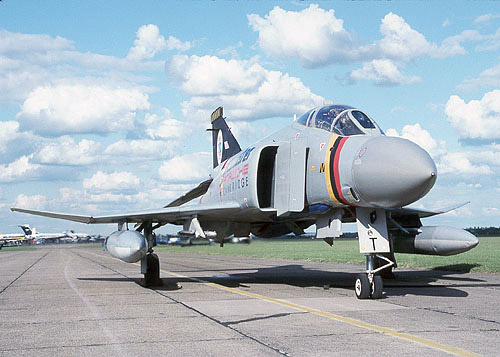 Part
Seven: Chopper city by
Dave Eade
Part
Seven: Chopper city by
Dave Eade
So the Phantoms departed for pastures new, although none were ever to fly again. Most ended their days under the scrapman's axe, but some escaped as 'Battle Damage Repairs' at other airfields and a fortunate few made their way to museums. One, the previously infamous XV474, is still in running condition at Duxford, although now owned by the IWM and tucked away in one of the hangars. At Wattisham, the gate guard languished in a HAS for a while until airlifted away to guard another gate at Neatishead. RAF personnel swept up and packed boxes and in March 1993 the airfield was officially handed over to the British Army.
In the previous chapters of this tome, I have indicated that the RAF was always very friendly towards the spotting fraternity. I frequently found that if you asked, you got, if it was possible. Flights in the backseat of an F-4 were rare, it's true, but visits, talks and answers to questions were usually greeted in a positive manner. The Army – with its links to Northern Ireland - is a very different kettle of fish.
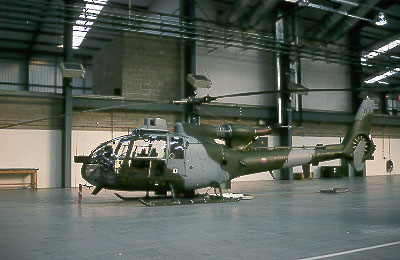 After
the announcement in late 1991 that Wattisham was to become an Army Air
Corps station, called Wattisham Airfield, and house a large consignment
of helicopters, most of my spotter friends were enthusiastic – at
least it wasn’t going to rot. The lay-bys around the airfield, especially
Crash Gate 2, kept their day-time viewers and the night time courting
couples – much as before – although there was nothing to see.
Building work took place at a phenomenal rate, with new housing, three
huge hangars, a new HQ building between the old hangars two & three
and the removal of the famous Q-sheds being the main visual aspects. Security
overtook the enthusiasm of spotters when a twelve foot high chain-link
fence was placed around the whole airfield, impeding the view, in early
1993. Where spotters had met and greeted Phantom jocks a mere year before,
they were now moved on in a very unfriendly way from Crash Gate 2, and
the copse of trees near the gate – so long the toilet area for spotters
during exercises, was laid to the ground – presumably in an attempt
to dissuade.
After
the announcement in late 1991 that Wattisham was to become an Army Air
Corps station, called Wattisham Airfield, and house a large consignment
of helicopters, most of my spotter friends were enthusiastic – at
least it wasn’t going to rot. The lay-bys around the airfield, especially
Crash Gate 2, kept their day-time viewers and the night time courting
couples – much as before – although there was nothing to see.
Building work took place at a phenomenal rate, with new housing, three
huge hangars, a new HQ building between the old hangars two & three
and the removal of the famous Q-sheds being the main visual aspects. Security
overtook the enthusiasm of spotters when a twelve foot high chain-link
fence was placed around the whole airfield, impeding the view, in early
1993. Where spotters had met and greeted Phantom jocks a mere year before,
they were now moved on in a very unfriendly way from Crash Gate 2, and
the copse of trees near the gate – so long the toilet area for spotters
during exercises, was laid to the ground – presumably in an attempt
to dissuade.
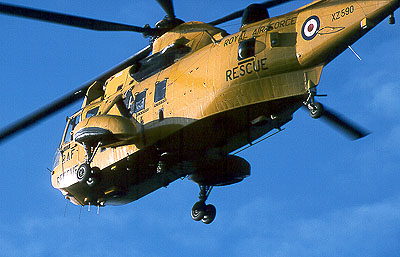 Removal
of the Q-sheds was to make way for the Air Force to return in the form
of B Flight of 22 Squadron from Manston, equipped with Sea King HAR3 Air-Sea
rescue helicopters. A large building and hangar arose from the foundations
of the Q-sheds, providing a self-contained enclave for the flight and
its pet Tarantula spider! Initially surrounded by controversy, the loss
of Coltishall Wessii together with the move from Manston gave fear that
large parts of the coastline would be too far from the heart of the Suffolk
countryside, it was apparent that the Sea Kings were going to be busy.
Although grey on arrival, the aircraft were soon traded for yellow ones,
and are to be seen almost daily on missions involving hospitals, ships
and wayward swimmers, along with their main task of supporting downed
aircrew. Rumours abound that the Squadron does not get on with its landlords,
who are said to deny the existence of the air force, but this is probably
friendly banter. It goes without saying that to a downed AAC pilot, the
sight of a bright Yellow Sea King is as good as to any other member of
the human race!
Removal
of the Q-sheds was to make way for the Air Force to return in the form
of B Flight of 22 Squadron from Manston, equipped with Sea King HAR3 Air-Sea
rescue helicopters. A large building and hangar arose from the foundations
of the Q-sheds, providing a self-contained enclave for the flight and
its pet Tarantula spider! Initially surrounded by controversy, the loss
of Coltishall Wessii together with the move from Manston gave fear that
large parts of the coastline would be too far from the heart of the Suffolk
countryside, it was apparent that the Sea Kings were going to be busy.
Although grey on arrival, the aircraft were soon traded for yellow ones,
and are to be seen almost daily on missions involving hospitals, ships
and wayward swimmers, along with their main task of supporting downed
aircrew. Rumours abound that the Squadron does not get on with its landlords,
who are said to deny the existence of the air force, but this is probably
friendly banter. It goes without saying that to a downed AAC pilot, the
sight of a bright Yellow Sea King is as good as to any other member of
the human race!
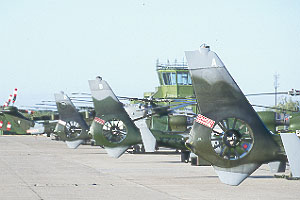 Established
on the airfield in the summer of '93, the Army Air Corps presence is due
to the re-location from Germany of 3 and 4 Regiments, who are the caretakers
of some forty-plus Westland Lynx, of both AH7
and AH9 versions, along with about twenty Gazelle
AH1s. All come under the banner of the 24th Airmobile Brigade, with
its HQ at Colchester Garrison. Also in residence is 7 Battalion R.E.M.E.
which is the Army’s 2nd line repair unit for all helicopters.
Established
on the airfield in the summer of '93, the Army Air Corps presence is due
to the re-location from Germany of 3 and 4 Regiments, who are the caretakers
of some forty-plus Westland Lynx, of both AH7
and AH9 versions, along with about twenty Gazelle
AH1s. All come under the banner of the 24th Airmobile Brigade, with
its HQ at Colchester Garrison. Also in residence is 7 Battalion R.E.M.E.
which is the Army’s 2nd line repair unit for all helicopters.
To further complicate the issue, each Regiment supports three squadrons of aircraft, and unlike the RAF, the squadrons fly different types of aircraft within the unit.
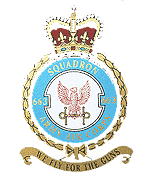
| No. 3 Regiment | No 4 Regiment |
| 653 Sqn – Lynx 9 | 654 Sqn – Gazelle & Lynx 7 |
| 662 Sqn – Gazelle & Lynx 7 | 659 Sqn – Lynx 9 |
| 663 Sqn - Gazelle & Lynx 7 | 669 Sqn – Gazelle & Lynx 7 |
Spotting is not easy with AAC aircraft
as serials are difficult to read in the camouflage of the fin boom, and
little squadron insignia is flown. Around the airfield, gaps in the hedges
have all but disappeared, through lack of use rather than any official
dicta, as now spotters give the field a wide berth. That's sad, from all
parties point of view. I well remember talking to a pilot from 56 Squadron,
while on a visit to the base with the Ipswich Aviation Society. He said
that they looked to the spotters as their eyes off  base
– seeing and knowing far more about what was going on than they could
possibly know. We were their off-base intelligence! Obviously the Army
takes a different view.
base
– seeing and knowing far more about what was going on than they could
possibly know. We were their off-base intelligence! Obviously the Army
takes a different view.
Publicity surrounding the units is mainly concerning their overseas deployments, previously to Bosnia and Croatia, as well as support in Northern Ireland. Training for their missions requires a lot of low-level work, which tends to be done at night, and particularly over the redundant USAF base at Woodbridge. A further big difference to the RAF days is that the Army often flies weekends! This, at least, can mean a hour or two on a Saturday afternoon can see a small amount of action. Since the Sea Kings arrived, the trusty old HAR3s have been replaced with the new-build HAR3A, which offers an automated hover system enabling the aircraft to remain over a fixed point, no matter what the conditions. One wag was heard to remark that it would be possible to set the machine in the hover, climb down the rope ladder, return to the mess for a cup of tea then after suitable relaxation climb back on board to resume the flight! Whether this has been tested in anger yet has to be established!
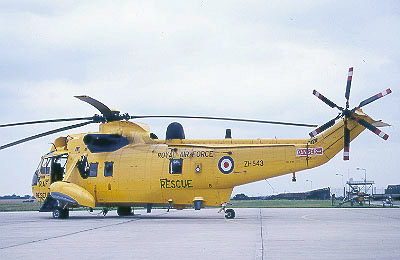 Each
squadron has its own 'CRO' dealing with public affairs, which can make
it disjointed. One has to say, however, that the Corps goes out of its
way to encourage schools, CCF units and is a great charity supporter,
often placing a chopper on static at Fetes and other Community Events.
Two Air Days have been held since the AAC took up residence, and a third
one was cancelled due to the funeral of the Princess of Wales in August
1997. The second show showed obvious learning from the short-falls of
the first, although they fell into the trap of advertising an appearance
by the Red Arrows, which was true, but merely in the form of a flypast.
Not many of the public realised that before the event! The AAC are not
the first, and won't be the last to drop this clanger – the Eye Show
in Suffolk being guilty on one occasion.
Each
squadron has its own 'CRO' dealing with public affairs, which can make
it disjointed. One has to say, however, that the Corps goes out of its
way to encourage schools, CCF units and is a great charity supporter,
often placing a chopper on static at Fetes and other Community Events.
Two Air Days have been held since the AAC took up residence, and a third
one was cancelled due to the funeral of the Princess of Wales in August
1997. The second show showed obvious learning from the short-falls of
the first, although they fell into the trap of advertising an appearance
by the Red Arrows, which was true, but merely in the form of a flypast.
Not many of the public realised that before the event! The AAC are not
the first, and won't be the last to drop this clanger – the Eye Show
in Suffolk being guilty on one occasion.
Busier now than its has probably ever been,
Wattisham has a secure future, the arrival of the Westland built Longbow
Apache being eagerly awaited next year which will give the AAC a quantum
leap into the future in terms of firepower and sophistication. Wattisham
looks set to become the focus for all AAC Air Cavalry operations with
most of the operational Apaches being located here, a few will go to Middle
Wallop for training purposes. How long the RAF will remain with the SAR
detachment is unsure as privatisation rumblings are gathering momentum
within the corridors of Whitehall. The HAS farms on each side of the airfield
are kept ready 'just in case', but it will take a national emergency of
critical proportions before Typhoons ever taxi up
to them. But, we can look forward to C-130Js from time to time to ferry
the Air Cavalry off to wherever they may have to train and fight. As this
is being written in February 1999, two  Hawks
from 100 Squadron are on detachment, providing some 'fast jet' activity
for the first time in a long while. Long may these deployments continue
to happen!
Hawks
from 100 Squadron are on detachment, providing some 'fast jet' activity
for the first time in a long while. Long may these deployments continue
to happen!
At least I have been able to end this review on a positive note. Any reader with comments or corrections is welcome to e-mail us – good or bad. If nothing else, though I have enjoyed the trundle through my memories – I hope you did too. It has been a privilege and a pleasure, living with an airbase on my doorstep, giving me a life-long hobby and enjoyment.
So, we await Apache, but don’t get excited spotters – serials will be even harder to read on Apaches than Gazelles and Lynxes! Part eight has begun...